Corinthian order
The Corinthian order (Greek: Κορινθιακὸς ῥυθμός, Korinthiakós rythmós; Latin: Ordo Corinthius) is the last developed and most ornate of the three principal classical orders of Ancient Greek architecture and Roman architecture. The other two are the Doric order which was the earliest, followed by the Ionic order. In Ancient Greek architecture, the Corinthian order follows the Ionic in almost all respects other than the capitals of the columns, though this changed in Roman architecture.[1]

.jpg.webp)
A Corinthian capital may be seen as an enriched development of the Ionic capital, though one may have to look closely at a Corinthian capital to see the Ionic volutes ("helices"), at the corners, perhaps reduced in size and importance, scrolling out above the two ranks of stylized acanthus leaves and stalks ("cauliculi" or caulicoles), eight in all, and to notice that smaller volutes scroll inwards to meet each other on each side. The leaves may be quite stiff, schematic and dry, or they may be extravagantly drilled and undercut, naturalistic and spiky. The flat abacus at the top of the capital has a concave curve on each face, and usually a single flower ("rosette") projecting from the leaves below overlaps it on each face.
When classical architecture was revived during the Renaissance, two more orders were added to the canon: the Tuscan order and the Composite order, known in Roman times, but regarded as a grand imperial variant of the Corinthian. The Corinthian has fluted columns and elaborate capitals decorated with acanthus leaves and scrolls. There are many variations.[2]
The name Corinthian is derived from the ancient Greek city of Corinth, although it was probably invented in Athens.[3]
Description
Greek Corinthian order
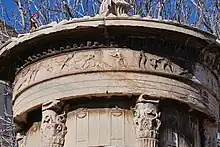
The Corinthian order is named for the Greek city-state of Corinth, to which it was connected in the period. However, according to the architectural historian Vitruvius, the column was created by the sculptor Callimachus, probably an Athenian, who drew acanthus leaves growing around a votive basket of toys, with a slab on top, on the grave of a Corinthian girl.[3]
Its earliest use can be traced back to the Late Classical Period (430–323 BC). The earliest Corinthian capitals, already in fragments and now lost, were found in Bassae in 1811-12; they are dated around 420 BC, and are in a temple of Apollo otherwise using the Ionic. There were three of them, carrying the frieze across the far end of the cella, which was open to the adytum. The Corinthian was probably devised to solve the awkwardness the Ionic capital created at corners by having clear and distinct front or back and side-on faces,[4] a problem only finally solved by Vincenzo Scamozzi in the 16th century.
Roman Corinthian order
.jpg.webp)
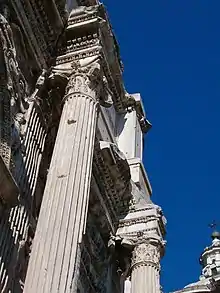
.jpg.webp)
The style developed its own model in Roman practice, following precedents set by the Temple of Mars Ultor in the Forum of Augustus (c. 2 AD).[5] It was employed in southern Gaul at the Maison Carrée, Nîmes and at the comparable Temple of Augustus and Livia at Vienne. Other prime examples noted by Mark Wilson Jones are the lower order of the Basilica Ulpia and the Arch of Trajan at Ancona (both of the reign of Trajan, 98–117 AD), the Column of Phocas (re-erected in Late Antiquity but 2nd century in origin), and the Temple of Bacchus at Baalbek (c. 150 AD).[6]
Proportion is a defining characteristic of the Corinthian order: the "coherent integration of dimensions and ratios in accordance with the principles of symmetria" are noted by Mark Wilson Jones, who finds that the ratio of total column height to column-shaft height is in a 6:5 ratio, so that, secondarily, the full height of column with capital is often a multiple of 6 Roman feet while the column height itself is a multiple of 5. In its proportions, the Corinthian column is similar to the Ionic column, though it is more slender, and stands apart by its distinctive carved capital.[7]
The abacus upon the capital has concave sides to conform to the outscrolling corners of the capital, and it may have a rosette at the center of each side. Corinthian columns were erected on the top level of the Roman Colosseum, holding up the least weight, and also having the slenderest ratio of thickness to height. Their height to width ratio is about 10:1.[7]
One variant is the Tivoli order, found at the Temple of Vesta, Tivoli. The Tivoli order's Corinthian capital has two rows of acanthus leaves and its abacus is decorated with oversize fleurons in the form of hibiscus flowers with pronounced spiral pistils. The column flutes have flat tops. The frieze exhibits fruit festoons suspended between bucrania. Above each festoon has a rosette over its center. The cornice does not have modillions.
Gandharan capitals
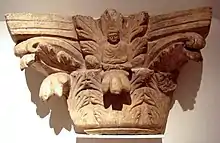
Indo-Corinthian capitals are capitals crowning columns or pilasters, which can be found in the northwestern Indian subcontinent, and usually combine Hellenistic and Indian elements. These capitals are typically dated to the 1st centuries of our era, and constitute important elements of Greco-Buddhist art of Gandhara.
The classical design was often adapted, usually taking a more elongated form, and sometimes being combined with scrolls, generally within the context of Buddhist stupas and temples. Indo-Corinthian capitals also incorporated figures of the Buddha or Bodhisattvas, usually as central figures surrounded, and often in the shade, of the luxurious foliage of Corinthian designs.
Byzantine Empire and Medieval Europe
Though the term "Corinthian" is reserved for columns and capitals that adhere fairly closely to one of the classical versions, vegetal decoration to capitals continued to be extremely common in Byzantine architecture and the various styles of the European Middle Ages, from Carolingian architecture to Romanesque architecture and Gothic architecture. There was considerable freedom in the details and the relationship between column (generally not fluted) and capital. Many types of plant were represented, sometimes realistically, as in the capitals in the chapter house at Southwell Minster in England.
Renaissance Corinthian order

During the first flush of the Italian Renaissance, the Florentine architectural theorist Francesco di Giorgio expressed the human analogies that writers who followed Vitruvius often associated with the human form, in squared drawings he made of the Corinthian capital overlaid with human heads, to show the proportions common to both.[8]
The Corinthian architrave is divided in two or three sections, which may be equal, or may bear interesting proportional relationships, to one with another. Above the plain, unadorned architrave lies the frieze, which may be richly carved with a continuous design or left plain, as at the U.S. Capitol extension. At the Capitol the proportions of architrave to frieze are exactly 1:1. Above that, the profiles of the cornice mouldings are like those of the Ionic order. If the cornice is very deep, it may be supported by brackets or modillions, which are ornamental brackets used in a series under a cornice.
The Corinthian column is almost always fluted, and the flutes of a Corinthian column may be enriched. They may be filleted, with rods nestled within the hollow flutes, or stop-fluted, with the rods rising a third of the way, to where the entasis begins. In French, these are called chandelles and sometimes terminate in carved wisps of flame, or with bellflowers. Alternatively, beading or chains of husks may take the place of the fillets in the fluting, Corinthian being the most flexible of the orders, with more opportunities for variation.
Elaborating upon an offhand remark when Vitruvius accounted for the origin of its acanthus capital, it became a commonplace to identify the Corinthian column with the slender figure of a young girl; in this mode the classifying French painter Nicolas Poussin wrote to his friend Fréart de Chantelou in 1642:
The beautiful girls whom you will have seen in Nîmes will not, I am sure, have delighted your spirit any less than the beautiful columns of Maison Carrée for the one is no more than an old copy of the other.[9]
Sir William Chambers expressed the conventional comparison with the Doric order:
The proportions of the orders were by the ancients formed on those of the human body, and consequently, it could not be their intention to make a Corithian column, which, as Vitruvius observes, is to represent the delicacy of a young girl, as thick and much taller than a Doric one, which is designed to represent the bulk and vigour of a muscular full grown man.[10]
History
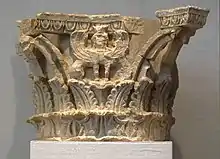
The oldest known example of a Corinthian column is in the Temple of Apollo Epicurius at Bassae in Arcadia, c. 450–420 BC. It is not part of the order of the temple itself, which has a Doric colonnade surrounding the temple and an Ionic order within the cella enclosure. A single Corinthian column stands free, centered within the cella. This is a mysterious feature, and archaeologists debate what this shows: some state that it is simply an example of a votive column. A few examples of Corinthian columns in Greece during the next century are all used inside temples. A more famous example, and the first documented use of the Corinthian order on the exterior of a structure, is the circular Choragic Monument of Lysicrates in Athens, erected c. 334 BC.
A Corinthian capital carefully buried in antiquity in the foundations of the circular tholos at Epidaurus was recovered during modern archaeological campaigns. Its enigmatic presence and preservation have been explained as a sculptor's model for stonemasons to follow[11] in erecting the temple dedicated to Asclepius. The architectural design of the building was credited in antiquity to the sculptor Polykleitos the Younger, son of the Classical Greek sculptor Polykleitos the Elder.
The temple was erected in the 4th century BC. These capitals, in one of the most-visited sacred sites of Greece, influenced later Hellenistic and Roman designs for the Corinthian order. The concave sides of the abacus meet at a sharp keel edge, easily damaged, which in later and post-Renaissance practice has generally been replaced by a canted corner. Behind the scrolls the spreading cylindrical form of the central shaft is plainly visible.
Much later, the Roman writer Vitruvius (c. 75 BC – c. 15 BC) related that the Corinthian order had been invented by Callimachus, a Greek architect and sculptor who was inspired by the sight of a votive basket that had been left on the grave of a young girl. A few of her toys were in it, and a square tile had been placed over the basket, to protect them from the weather. An acanthus plant had grown through the woven basket, mixing its spiny, deeply cut leaves with the weave of the basket.[12]

Claude Perrault incorporated a vignette epitomizing the Callimachus tale in his illustration of the Corinthian order for his translation of Vitruvius, published in Paris, 1684. Perrault demonstrates in his engraving how the proportions of the carved capital could be adjusted according to demands of the design, without offending. The texture and outline of Perrault's leaves is dry and tight compared to their 19th-century naturalism at the U.S. Capitol.
In Late Antique and Byzantine practice, the leaves may be blown sideways, as if by the wind of Faith. Unlike the Doric and Ionic column capitals, a Corinthian capital has no neck beneath it, just a ring-like astragal molding or a banding that forms the base of the capital, recalling the base of the legendary basket.
Most buildings (and most clients) are satisfied with just two orders. When orders are superposed one above another, as they are at the Colosseum, the natural progression is from sturdiest and plainest (Doric) at the bottom, to slenderest and richest (Corinthian) at the top. The Colosseum's topmost tier has an unusual order that came to be known as the Composite order during the 16th century. The mid-16th-century Italians, especially Sebastiano Serlio and Jacopo Barozzi da Vignola, who established a canonic version of the orders, thought they detected a "Composite order", combining the volutes of the Ionic with the foliage of the Corinthian, but in Roman practice volutes were almost always present.
In Romanesque and Gothic architecture, where the Classical system had been replaced by a new aesthetic composed of arched vaults springing from columns, the Corinthian capital was still retained. It might be severely plain, as in the typical Cistercian architecture, which encouraged no distraction from liturgy and ascetic contemplation, or in other contexts it could be treated to numerous fanciful variations, even on the capitals of a series of columns or colonettes within the same system.
During the 16th century, a sequence of engravings of the orders in architectural treatises helped standardize their details within rigid limits: Sebastiano Serlio; the Regola delli cinque ordini of Giacomo Barozzi da Vignola (1507–1573); I quattro libri dell'architettura of Andrea Palladio, and Vincenzo Scamozzi's L'idea dell'architettura universale, were followed in the 17th century by French treatises with further refined engraved models, such as Perrault's.
Notable examples
.jpg.webp)
- Argentina
- Bangladesh
- Tajhat Palace, Rangpur
- France
- Maison Carrée, Nimes
- The July Column, Paris
- Germany
- Palatine Chapel, Aachen
- The Reichstag, Berlin
- Greece
- Israel
- Italy
- Jordan
- Philippines
- Portugal
- Romania
- New Saint George Church of Bucharest
- Royal Palace of Bucharest
- The Church from the Antim Monastery
- Central University Library of Bucharest
- Monteoru House
- Russia
- Singapore
- South Africa
- Syria
- Ukraine
- Great Lavra Belltower (fourth tier – 8 columns)
- Independence Monument
- United Kingdom
- United States of America
Gallery
 Reconstructed Corinthian capital, with original colours
Reconstructed Corinthian capital, with original colours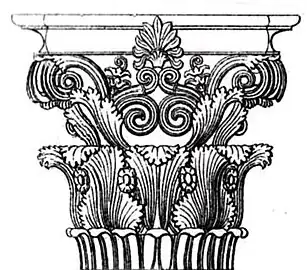 Early Corinthian capital from the Choragic Monument of Lysicrates Athens, c. 335 BC
Early Corinthian capital from the Choragic Monument of Lysicrates Athens, c. 335 BC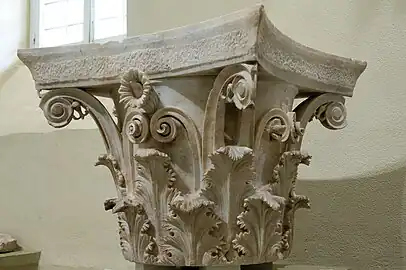 Ancient Greek Corinthian capital from the tholos at Epidaurus, Archaeological Museum of Epidaurus, Greece, said to have been designed by Polyclitus the Younger, c.350 BC[13]
Ancient Greek Corinthian capital from the tholos at Epidaurus, Archaeological Museum of Epidaurus, Greece, said to have been designed by Polyclitus the Younger, c.350 BC[13]_(30776483926).jpg.webp) Ancient Greek Temple of Olympian Zeus, Athens, 174 BC–c.130 AD[14]
Ancient Greek Temple of Olympian Zeus, Athens, 174 BC–c.130 AD[14]_(3492384864).jpg.webp) Roman Corinthian capitals in the Temple of Hercules Victor, Rome, later 2nd century BC
Roman Corinthian capitals in the Temple of Hercules Victor, Rome, later 2nd century BC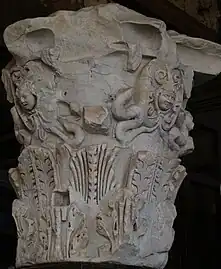
.jpg.webp) The variant known as "Tower of the Winds Corinthian" after the monument in Athens
The variant known as "Tower of the Winds Corinthian" after the monument in Athens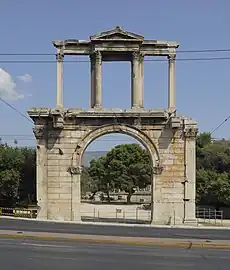 Roman Corinthian columns and pilasters of the Arch of Hadrian, Athens, 131 or 132 AD
Roman Corinthian columns and pilasters of the Arch of Hadrian, Athens, 131 or 132 AD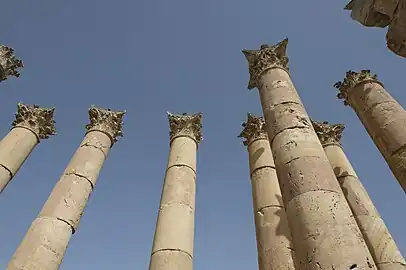
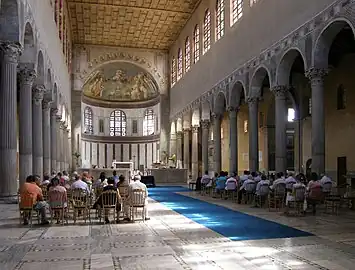 The Constantinian basilica of Santa Sabina interior, with spolia Corinthian columns from the Temple of Juno Regina
The Constantinian basilica of Santa Sabina interior, with spolia Corinthian columns from the Temple of Juno Regina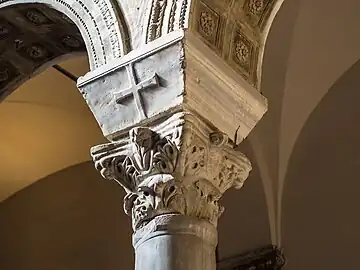
_Abbatiale_Saint-Philibert_-_Int%C3%A9rieur_-_Chapiteau_-_13.jpg.webp) Romanesque quasi-Corinthian capital, Church of St. Philibert, Tournus, France, c.1008 to mid-11th century[15]
Romanesque quasi-Corinthian capital, Church of St. Philibert, Tournus, France, c.1008 to mid-11th century[15]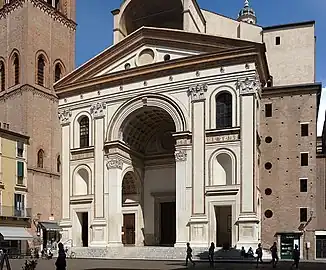 Renaissance Corinthian pilasters of the Basilica of Sant'Andrea, Mantua, Italy, Leon Battista Alberti, begun in c.1450[16]
Renaissance Corinthian pilasters of the Basilica of Sant'Andrea, Mantua, Italy, Leon Battista Alberti, begun in c.1450[16]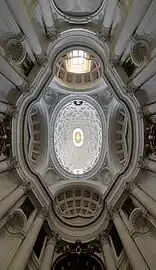 Baroque Corinthian column capitals in the San Carlo alle Quattro Fontane, Rome, by Francesco Borromini, 1638–1677
Baroque Corinthian column capitals in the San Carlo alle Quattro Fontane, Rome, by Francesco Borromini, 1638–1677 Baroque Corinthian columns in the Chapel of the Palace of Versailles, 1696–1710[17]
Baroque Corinthian columns in the Chapel of the Palace of Versailles, 1696–1710[17]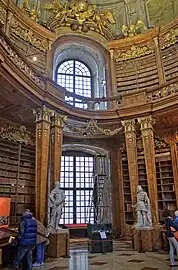 Stylized Baroque Corinthian columns in the Austrian National Library, Hofburg, Vienna, Austria, designed by Johann Bernhard Fischer von Erlach in c.1716–1720, built in 1723–1726[18]
Stylized Baroque Corinthian columns in the Austrian National Library, Hofburg, Vienna, Austria, designed by Johann Bernhard Fischer von Erlach in c.1716–1720, built in 1723–1726[18].jpg.webp) Brâncovenesc Corinthian capitals of the Stavropoleos Monastery Church, Bucharest, Romania, unknown architect, 1724
Brâncovenesc Corinthian capitals of the Stavropoleos Monastery Church, Bucharest, Romania, unknown architect, 1724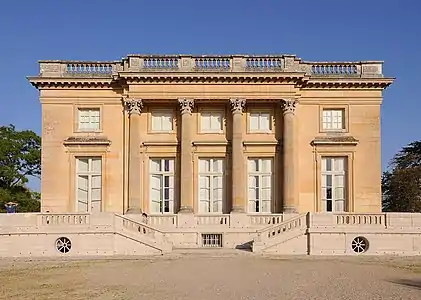
_01.jpg.webp) Neoclassical Corinthian pilaster in the Salon des dames d'honneur, Château de Compiègne, Compiègne, France, unknown architect, c.1810
Neoclassical Corinthian pilaster in the Salon des dames d'honneur, Château de Compiègne, Compiègne, France, unknown architect, c.1810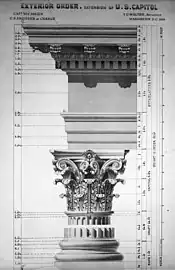 The Neoclassical Corinthian order as used in extending the United States Capitol in 1854: the column's shaft has been omitted
The Neoclassical Corinthian order as used in extending the United States Capitol in 1854: the column's shaft has been omitted Neoclassical reinterpretation of the Corinthian capital at the Grave of Claude Bonnefond, Loyasse Cemetery, Lyon, France, designed by Antoine-Marie Chenavard and sculpted by Guillaume Bonnet, c.1860
Neoclassical reinterpretation of the Corinthian capital at the Grave of Claude Bonnefond, Loyasse Cemetery, Lyon, France, designed by Antoine-Marie Chenavard and sculpted by Guillaume Bonnet, c.1860 Beaux Arts Corinthian columns on the facade of the Palais Garnier, Paris, by Charles Garnier, 1861–1874[19]
Beaux Arts Corinthian columns on the facade of the Palais Garnier, Paris, by Charles Garnier, 1861–1874[19]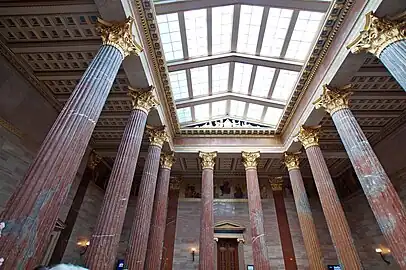 Greek Revival Corinthian columns in the Austrian Parliament Building, Vienna, by Theophil von Hansen, 1873–1883[20]
Greek Revival Corinthian columns in the Austrian Parliament Building, Vienna, by Theophil von Hansen, 1873–1883[20] Greek Revival pilaster capitals on the facade of the Austrian Parliament Building
Greek Revival pilaster capitals on the facade of the Austrian Parliament Building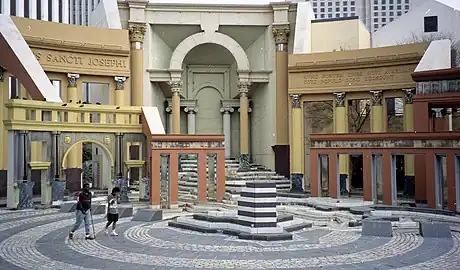 Postmodern Corinthian columns of the Piazza d'Italia, New Orleans, US, by Charles Moore, 1978–1979[21]
Postmodern Corinthian columns of the Piazza d'Italia, New Orleans, US, by Charles Moore, 1978–1979[21] Postmodern neon Corinthian capital in South Bay Galleria, Redondo Beach, California, US, by RTKL Associates and Theo Kondos Associates, 1985
Postmodern neon Corinthian capital in South Bay Galleria, Redondo Beach, California, US, by RTKL Associates and Theo Kondos Associates, 1985.jpg.webp) Reinterpreted Postmodern Corinthian columns of the Pumping Station, Isle of Dogs, London, John Outram, 1988[22]
Reinterpreted Postmodern Corinthian columns of the Pumping Station, Isle of Dogs, London, John Outram, 1988[22]
See also
Notes
- Lawrence, 85; Summerson, 124, 176
- "Corinthian Columns". Architect of the Capitol. Retrieved 2019-03-24.
- Summerson, 124
- Lawrence, 179 (Plate 80)
- Mark Wilson Jones, "Designing the Roman Corinthian order", Journal of Roman Archaeology 2:35-69 (1989).
- Jones 1989.
- Peter D'Epiro; Mary Desmond Pinkowish (22 December 2010). What are the Seven Wonders of the World?: And 100 Other Great Cultural Lists--Fully Explicated. Knopf Doubleday Publishing Group. p. 133. ISBN 978-0-307-49107-7.
- Francesco di Giorgio's sheet with the drawings, from the Turin codex Saluzziano of his Trattati di architettura ingegneria e arte militare, c. 1480–1500, is illustrated by Rudolf Wittkower, Architectural Principles in the Age of Humanism (1962) 1965, pl. ic
- Quoted by Sir Kenneth Clark, The Nude: A Study in Ideal Form, 1956, p. 45.
- Chambers, A Treatise on the Decorative Part of Civil Architecture (Joseph Gwilt ed, 1825:pp 159–61).
- Alison Burford (The Greek Temple Builders at Epidauros, Liverpool, 1969, p. 65) suggests instead that it was spoilt in the carving, one volute being incorrectly detached from its field; Hugh Plommer, reviewing it for The Classical Review (New Series, 21.2 [June 1971], pp 269–272), remarks that the error involved an excess of work and remains convinced that the capital was a model.
- Vitr. 4.1.9-10
- Hugh Honour, John Fleming (2009). A World History of Art - Revised Seventh Edition. Laurence King Publishing. p. 147. ISBN 978-1-85669-584-8.
- Hugh Honour, John Fleming (2009). A World History of Art - Revised Seventh Edition. Laurence King Publishing. p. 177. ISBN 978-1-85669-584-8.
- Watkin, David (2022). A History of Western Architecture. Laurence King. p. 123. ISBN 978-1-52942-030-2.
- Watkin, David (2022). A History of Western Architecture. Laurence King. p. 217. ISBN 978-1-52942-030-2.
- Martin, Henry (1927). Le Style Louis XIV (in French). Flammarion. p. 39.
- Watkin, David (2022). A History of Western Architecture. Laurence King. p. 325. ISBN 978-1-52942-030-2.
- Robertson, Hutton (2022). The History of Art - From Prehistory to Presentday - A Global View. Thames & Hudson. p. 989. ISBN 978-0-500-02236-8.
- Watkin, David (2022). A History of Western Architecture. Laurence King. p. 490. ISBN 978-1-52942-030-2.
- Hugh Honour, John Fleming (2009). A World History of Art - Revised Seventh Edition. Laurence King Publishing. p. 867. ISBN 978-1-85669-584-8.
- Gura, Judith (2017). Postmodern Design Complete. Thames & Hudson. p. 121. ISBN 978-0-500-51914-1.
References
- Lawrence, A. W., Greek Architecture, 1957, Penguin, Pelican history of art
- Summerson, John, The Classical Language of Architecture, 1980 edition, Thames and Hudson World of Art series, ISBN 0500201773